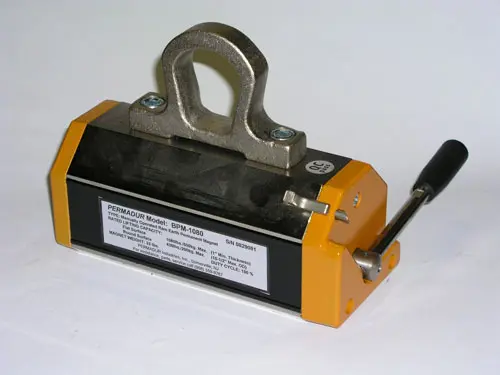In material handling, selecting the right tools can significantly enhance efficiency and safety. Two notable options in the market for manual lifting magnets are BPM-style manual Magnets and REM-style manual Magnets. Both product lines offer unique features and capabilities, and choosing between them depends on specific needs and applications. Understanding the difference between systems can be the difference between optimal and poor performance.
Product Range and Specifications for BPM REM Manual Magnets
The BPM and REM series both offer a range of products designed to meet different load requirements. Still, their specifications differ notably regarding weight capacity, physical dimensions, and operational features.
BPM Series
- Range of Safe Working Load (SWL): The BPM series offers a variety of safe working loads, from 275 to 4320 lbs for flat materials and 110 to 1720 lbs for round materials. This range ensures suitability for various small—to mid-sized industrial applications.
- Magnet Weight: Ranges from 7 to 209 lbs, indicating varying portability and ease of handling. Lighter models are ideal for quick jobs and frequent moving, while heavier models provide more stability and lifting power.
- Dimensions and Headroom: These magnets have varying body sizes and headroom, making them suitable for different operational environments. Smaller dimensions allow for use in tighter spaces, a critical consideration in congested workplaces.
REM Series
- Range of Safe Working Load (SWL): The REM series manual magnets can handle from 220 to 6600 lbs for flat materials and 110 to 3000 lbs for rounds, covering a broader range of operational demands. These capacities make the REM series suitable for lightweight operations and more demanding industrial lifting.
- Magnet Weight: Ranges from 6 to 355 lbs, with some options being particularly heavier, aimed at more substantial lifting tasks. The heaviest models are designed for industrial environments where heavy-duty lifting is a routine requirement.
- Dimensions and Headroom: Generally, REM magnets are bulkier than BPM, which might impact their suitability in more compact spaces. The larger size, however, often translates into a higher lifting capacity, which is beneficial for large-scale operations.
Features and Benefits
Both BPM and REM manual magnets share several key features.
- High Magnet Capacity to Weight Ratio: Both series provide excellent lifting capacity relative to their weight, making them effective in robust material handling tasks. This feature allows for maximum efficiency without the need for excessive physical exertion or mechanical assistance.
- Safety Factor of 3 to 1: Ensures the magnets are safe and reliable in lifting operations. This high safety factor is critical in maintaining workplace safety, reducing the risk of accidents associated with overloading.
- Material: Utilizes NdFeB, the most potent permanent magnetic material, ensuring strong and durable performance. NdFeB magnets are renowned for their superior magnetic field strength and are integral to the efficiency of these lifting tools.
- Operation: Both lines boast simple lever operation mechanisms with a safety lock feature, enhancing user safety and ease of use. This operational simplicity is vital in fast-paced work environments where time and safety are of the essence.
Decision Making for Manual Magnet Options
Choosing between BPM and REM magnets should be based on specific lifting needs, workspace constraints, and safety considerations. BPM magnets might be more appropriate for smaller spaces or less frequent lifting of moderately heavy items due to their lighter weight and smaller sizes. For industrial environments with heavy and frequent lifting requirements, REM magnets offer higher capacities and the durability needed for such tasks. Although potentially less maneuverable, their larger sizes and heavier weights provide stability and strength for heavy loads.
While both BPM and REM magnets offer excellent features, choosing between them should align with specific operational requirements and environmental conditions. Each series caters to a range of needs, ensuring there is a magnet suitable for every type of lifting task.


